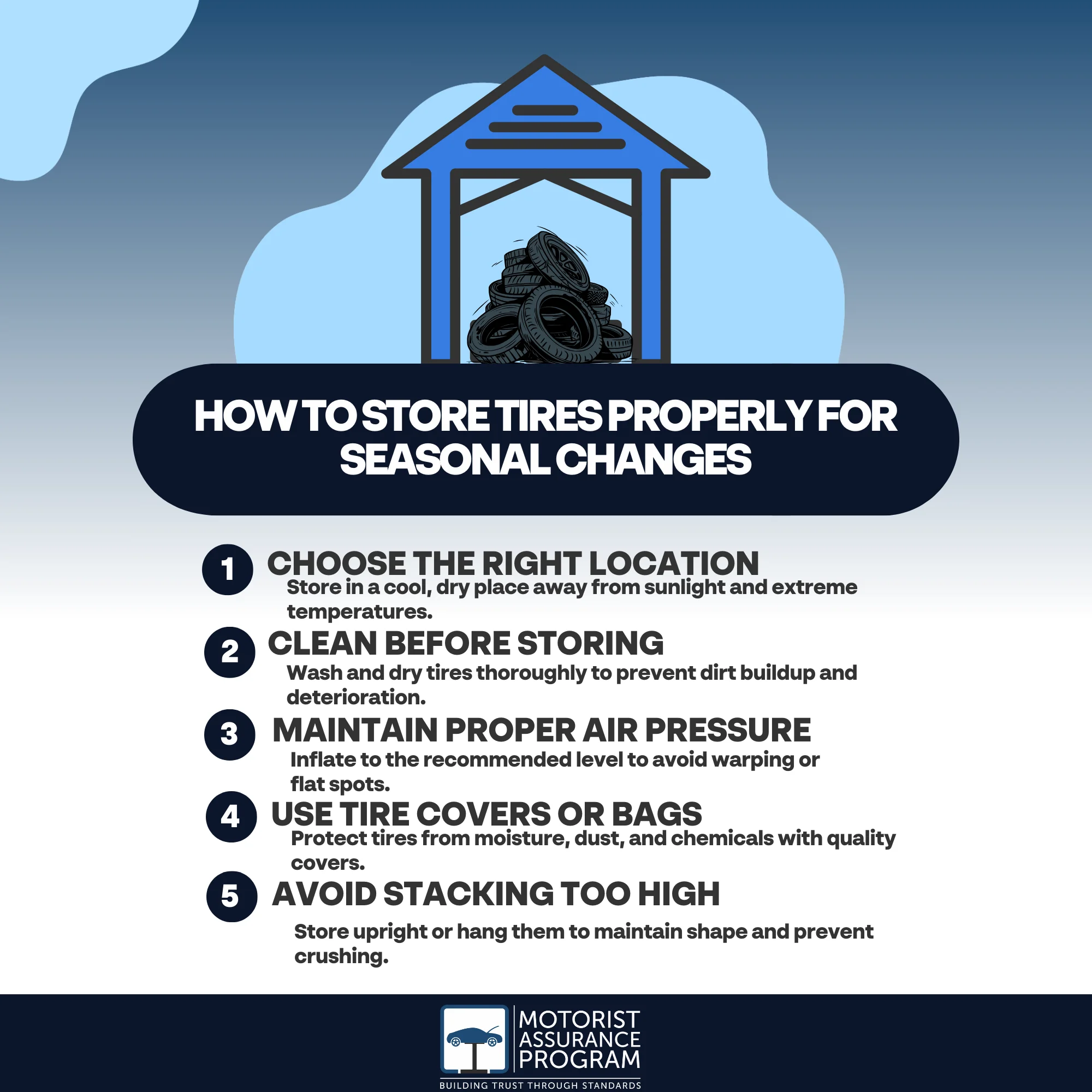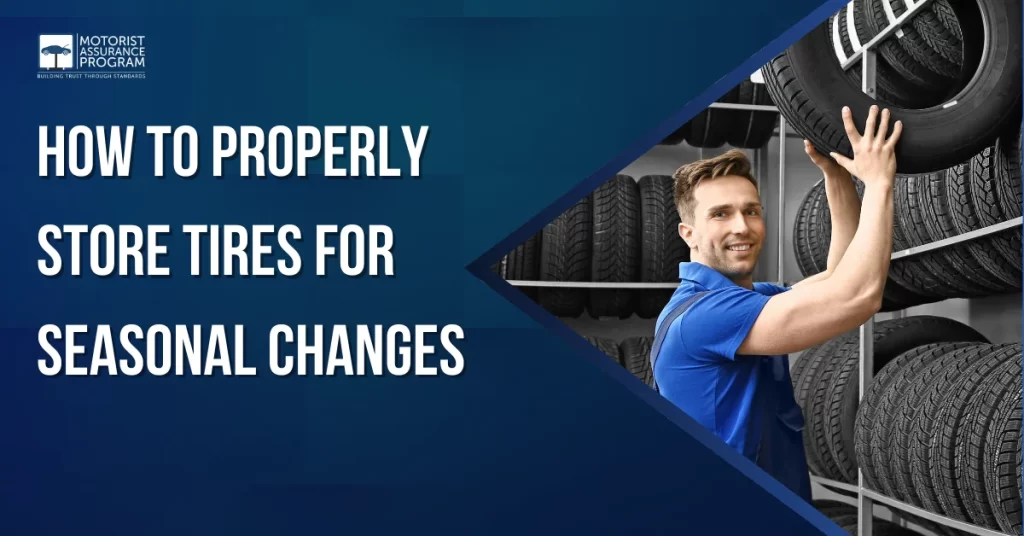To store your tires for seasonal changes properly, choose a cool, dry location away from sunlight and chemicals. Clean them thoroughly, ensuring they’re dry before storage. Inflate to the recommended pressure to avoid flat spots, and consider using bags or covers for protection. Avoid stacking them too high and keep an eye on air pressure. These simple steps will extend your tires’ lifespan and performance, and there’s more you might want to know about tire storage.

Key Takeaways
- Store tires in a cool, dry area away from direct sunlight and extreme temperatures to maintain their condition.
- Clean tires thoroughly with a mild soap solution and ensure they are completely dry before storage.
- Inflate tires to the manufacturer’s recommended pressure to prevent warping or flat spots during storage.
- Use high-quality plastic bags or tire covers to protect each tire from moisture and dirt.
- Keep tires away from harsh chemicals and corrosive materials to avoid degradation and extend their lifespan.
Choose the Right Storage Location
When you’re deciding where to store your tires, keep in mind that the right location can greatly impact their longevity. For seasonal tire storage, you’ll want a cool, dry area away from direct sunlight and extreme temperatures. A basement, garage, or storage unit can work well, but be cautious of dampness, which can cause mold or degradation. If you’re wondering, “where can I store my summer tires?” consider vertical racks or tire totes that keep them off the ground and prevent cupping. Avoid storing tires near chemicals or sharp objects that could cause damage. Properly choosing your storage location guarantees your tires remain in excellent condition until it’s time to switch them back on your vehicle.
Clean Your Tires Before Storage
Before storing your tires, it’s essential to clean them thoroughly, as dirt and debris can lead to damage over time. Start by using a soft brush and a mild soap solution to scrub the tires, focusing on the treads and sidewalls. Rinse them well and let them dry completely before storage. This step not only prevents deterioration but also guarantees you’re ready to roll when it’s time to use them again. If you’re unsure how to store tires for the winter, remember that clean tires have a lower seasonal tire storage cost, as they’re less likely to require maintenance or replacement. Taking this time to clean them can save you money and hassle in the long run.
Maintain Proper Air Pressure During Storage
Maintaining proper air pressure during tire storage is essential for preserving their integrity and performance. When you’re preparing for a seasonal tire change, make certain your seasonal tires are inflated to the manufacturer’s recommended pressure. Over-inflation can lead to tire warping, while under-inflation may cause flat spots that compromise performance. Ideally, check the air pressure before storing your tires and again before you install them for the next season. If you’re using tire racks, avoid stacking them too high, as this can also affect their shape. Regularly monitoring the air pressure guarantees that your tires remain in good condition, ready to deliver peak performance when you need them again. Proper care now saves you from issues later!
Bag and Protect Your Tires
Properly bagging and protecting your tires is essential for their longevity during storage. When you’re preparing for a seasonal tire changeover, follow these steps to guarantee your seasonal tires stay in great shape:
- Clean the tires thoroughly to remove dirt and grime.
- Dry them completely to prevent moisture buildup.
- Use high-quality plastic bags or tire covers to encase each tire.
- Store the tires in a cool, dry place away from direct sunlight.
Avoid Chemical Exposure
While you might not think about it, keeping your tires away from harsh chemicals is vital for their preservation. During a seasonal tire change or seasonal changeover, it’s important to store your tires in an environment free from substances like gasoline, oils, solvents, and other corrosive materials. These chemicals can degrade the rubber, leading to premature wear and potential safety hazards. Make sure that your storage area is clean and dry, and avoid placing your tires near any chemical containers. If you’ve had any repairs or maintenance done, check that the area where you store your tires hasn’t been contaminated. By being mindful of chemical exposure, you can extend the life of your tires and guarantee their best performance when it’s time to hit the road again.
Store Tires Properly: Stand, Stack, or Hang
After verifying your tires are free from chemical exposure, the next step is to think about how to store them. Proper storage can help avoid unnecessary seasonal tire change costs and extend tire life. Here are a few methods you can consider:
- Stand: Store tires upright on their sidewalls to prevent deformation.
- Stack: If you’ve got multiple tires, stack them horizontally, but avoid stacking more than four to prevent crushing.
- Hang: Use tire racks or hooks for hanging, which keeps tires off the ground and helps maintain shape.
- Cover: Regardless of the method, cover the tires with breathable materials to protect them from dust and UV damage.
Choose the best option based on your space and verify your tires are ready for the next seasonal change!
Frequently Asked Questions
How Long Can I Store Tires Before They Need Replacing?
Tires can be stored for up to six years, but their condition should be inspected frequently. If any signs of wear, like cracks or bulges, appear, it’s time to replace them, regardless of the storage period.
Can I Store Tires Outdoors if Covered?
You can store tires outdoors if they’re properly covered, but it’s not ideal. UV rays and extreme temperatures can damage them over time. It’s best to keep them in a cool, dry place whenever possible.
Should I Store Tires With Rims Attached?
It’s best to store tires with rims attached, as it prevents deformation and makes handling easier. However, if you remove them, stack the tires vertically to avoid flat spots and maintain their shape.
What Temperature Is Ideal for Tire Storage?
You’d think tires love extreme temperatures, but they don’t! Ideally, store them in a cool, dry place between 50°F and 70°F. Keeping them in this range helps maintain their integrity and longevity.
How Often Should I Check Stored Tires for Damage?
You should check stored tires for damage at least once a month. Look for any signs of cracks, bulges, or irregular wear. Regular inspections can help guarantee your tires stay in good condition when needed.
Conclusion
By following these tire storage tips, you can actually increase your tires’ lifespan and performance, defying the common belief that tires only need to be replaced when they wear down. Who knew that a little care could make such a difference? So, as you shift between seasons, remember: proper storage isn’t just about saving money; it’s about ensuring your vehicle handles safely and effectively when you hit the road again. Your tires deserve nothing but the best!


